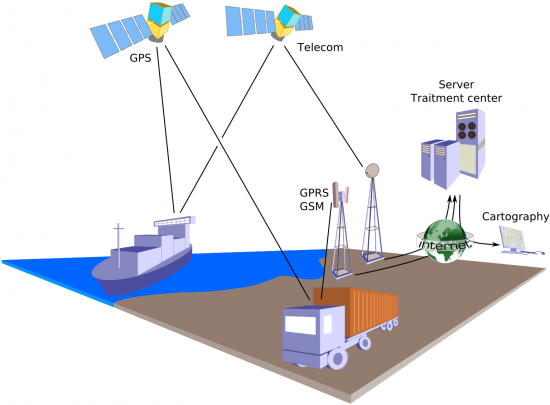If you wish to contribute or participate in the discussions about articles you are invited to contact the Editor
Package and Container Tracking
| Applications | |
|---|---|
| Title | Package and Container Tracking |
| Author(s) | GMV. |
| Level | Medium |
| Year of Publication | 2011 |
With GNSS asset tracking applications, companies can improve efficiency and control the distribution chain of their products and shipping's. These systems help to identify the location of cargo or containers equipped with GNSS receivers whilst in transit by road, rail or ships.
Usually vehicle management applications encompasses package and container tracking applications, allowing an integrated view of both cargo and vehicles.
Application Architecture
Package and Container Tracking, is closely connected with vehicles tracking. A system supporting vehicles fleet tracking can be extended to support the tracking of assets by incorporating low cost devices in the packages or containers.
The combination of GNSS technology with GSM can provide continuous real-time tracking and tracing information continually during the journey.
Application Characterization
The fleet management tracking is used for tracking of cargo, in tracks, ships or trains using the benefits for cargo management. Shipments can be located if stolen and customer service is enhanced with the ability for the shipper to accurately report delivery time.
Package and Container Tracking applications are very important for insurance companies, which can grant a tool to obtain proper data about the trail of a certain asset. The real time movements can be obtain, which allow the operators to take actions if an anomaly is detected.
Many trucks have different types of trailers, the truck's load carrying unit, (e.g., flat bed, refrigerated, curtain, box container). These units can be unfastened from the vehicle, which imply that each unit shall be monitored separately.
Shipping customers or logistic companies can analyze data to choose the most efficient shipper. Package and Container Tracking applications usually offer the following capabilities:
- Continuous assessing of real-time tracking and tracing information,
- Control of shipment in a specified route, according to the plan and authorized path,
- Incident prevention, due to the monitoring of status parameters,
- Alarm rising in case of anomaly condition detection,
- Recording and logging for regular roundup of reported incidents,
- Informing the emergency response forces for the emergency management arrangements,
- Safeguarding of expensive stolen cargo,
Tracking of Dangerous Goods and Livestock
The transportation of dangerous industrial waste from its originating source to the site where it will be treated is increasing every year. Trucks carrying the waste-filled containers typically travel through several European countries for two to three days. For security reasons, and to ensure that all the waste arrives where it is intended to, a small Italian company has developed an innovative tracking system which uses location data from the GNSS to accurately track all movements of the industrial waste throughout its journey.[1]
The safe transport of nuclear material is regulated by the Atomic Energy Agency (IAEA) rules. In Europe, the transport of radioactive material is also regulated by the laws regulating the transportation of dangerous goods. Such regulations classify the dangerous material such as nuclear waste and material, and establish rules for the relevant safe and controlled transportation.[2]
None of these regulations specifically oblige the use of positioning technology, although the use of GNSS provide enhanced and guaranteed positioning allowing to support law enforcement and to cope with security needs.
The application of satellite positioning for livestock traceability is becoming a general objective to support livestock transportation policies. Regulation in Europe, requires an appropriate navigation system allowing for recording and providing information equivalent to those required in the journey log and information concerning opening/closing of the loading flap. It also requires a temperature monitoring and recording system which alerts the driver of the vehicle when the temperature in the animal compartment reaches the maximum of 30°C or the minimum of 5°C and a sensor that detects when the loading door is opened or not. [2]
In livestock transportation, GNSS will permit to:
- Localize and continuously track and trace the vehicles transporting livestock in order to increase the efficiency of all activities related with livestock transportation.
- Generate reports about sensors information such as temperature, loading doors information, warning signals, etc. in order to improve the animal's welfare.
- Optimal route calculation to specify the most suitable roads and hence, to ensure a fast and safe delivery of the cargo.
- Geofencing and alarming.
- Recording of data for statistical and enforcement / governmental use.
Application Examples
Fleet management application appear in many OEM products such as:[3]
- Truck manufacturers (Mercedes-Benz, Volvo Group, Scania, MAN Nutzfahrzeuge, or DAF Trucks)
- Construction equipment manufacturers (Caterpillar, Volvo CE, Komatsu)
- Trailer manufacturers (Schmitz Cargobull, or Krone)
In R&D field, the GSA MENTORE project is an example of how EGNOS and GALILEO will support track and trace of sensitive assets.[2]
Notes
References
- ^ ESA Portal, Satellite helps make transportation of dangerous waste safer
- ^ a b c Cite error: Invalid
<ref>tag; no text was provided for refs namedgnsstracking - ^ European fleet management market,M2M Research Series

